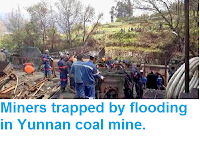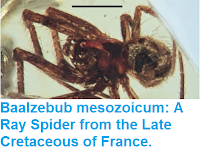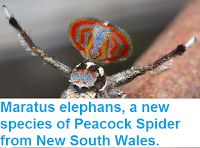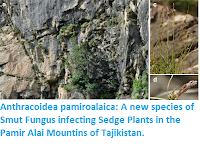The
breakup of the Gondwanan Supercontintent into its constituent parts
(South America, Antarctica, Africa, Madagascar, India, Australia, New
Zealand and some smaller landmasses) during the Cretaceous played an
important role in the distribution of terrestrial animals and plants
in the Southern Hemisphere that can still be seen today. How this
would have affected the distribution of large animals such as
Dinosaurs is particularly interesting, but is hard to assess as of
these continents only South America has a good terrestrial fossil
record extending all the way through the Cretaceous. Northern and
Southeast Africa, and eastern Australia have strata which produce
numerous terrestrial fossils including Dinosaurs, but almost no such
fossils are known from the Late Cretaceous here, while the reverse is
true in India, Madagascar and Antarctica, with numerous Late
Cretaceous Dinosaurs but very few Middle Cretaceous specimens.
In a
paper published in the journal
Scientific Reports on 20 October 2016,
Stephen Poropat of the
Department of Earth Sciences at
Uppsala University and the
Australian Age of Dinosaurs Museum of NaturalHistory,
Philip Mannion of the
Department of Earth Science and Engineering at
Imperial College London,
Paul Upchurch of the
Department of Earth Sciences at
University College London,
ScottHocknull of
Geosciences at the
Queensland Museum,
Benjamin Kear, also
of the Department of Earth Sciences at Uppsala University and of the
Museum of Evolution, also at Uppsala University,
Martin Kundrát of
the
Department of Ecology at
Comenius University and the
Center for Interdisciplinary Biosciences at the
University of Pavol Jozef Šafárik, and Travis Tischler, Trish Sloan, George Sinapius, Judy
Elliott and David Elliott, all of the Australian Age of Dinosaurs
Museum of Natural History, describe two new Sauropod Dinosaur
specimens from the early Late Cretaceous Winton Formation of Queensland.
The
Winton Formation is an iron rich sandstone laid down in a shallow inland sea (the Etomanga
Sea) and associated river systems that covered parts of Queensland and central Australia during the early Late Cretaceous (98-95 million years ago). which extends from Hungerford on the New South Wakes
border northwest to the area around Kynuna, a distance of over 1000
kilometres. This formation is famous for its Dinosaurs, but also produces Crocodylians, Turtles, Fish and a wide range of Invertebrates. It is also noted for the production of opals, which are typically found in cracks in ironstone concretions (themselves formed by
precipitation from water that has accumulated iron as it peculated
through the feruginous sandstone), and is commonly called 'boulder
opal'.
Map of
Queensland, northeast Australia, showing the distribution of
Cretaceous outcrop. Porapat et al.
(2016).
The first
specimen described is assigned to a new species and genus and named
Savannasaurus elliottorum, where 'Savannasaurus' refers
to the Savanah Grasslands where the specimen was found and
'elliottorum' honours the Elliott family for their
contributions to Australian palaeontology. The specimen comprises a
series of vertebrae and ribs plus a fragmentary scapula, a left
coracoid, the left and right sternal plates, incomplete left and
right humeri, a shattered ulna, the left radius a number of
metacarpals and phalanges, fragments of the left and right ilias, the
left and right pubes and ischia, fused together, the left astragalus
the right third metatarsal and some other fragmentary remains.

Savannasaurus
elliottorum. (a–e) Dorsal vertebrae (left lateral view). (f)
Sacrum (ventral view). (g,h) Caudal vertebrae (left lateral view).
(i) Left coracoid (lateral view). (j) Right sternal plate (ventral
view). (k) Left radius (posterior view). (l) Right metacarpal III
(anterior view). (m) Left astragalus (anterior view). (n) Co-ossified
right and left pubes (anterior view). A number of ribs were preserved
but have been omitted for clarity. Scale bar is 500 mm. Porapat et
al. (2016).
The
second of specimen is referred to the species Diamantinasaurus
matildae, which has previously been described from the Winton
Formation. This specimen comprises a left squamosal, a nearly
complete braincase, a right surangular, several skull fragments, the
atlas-axis, five post-axial cervical vertebrae, three dorsal
vertebrae, a partial sacrum, some dorsal ribs, a right scapula, both
iliac preacetabular processes, a paired pubes and ischia and some
other fragmentary material. The preservation of skull material in
this specimen is particularly noteworthy, as this is the first such
material known not only for this species but for any Australian
Sauropod.

Diamantinasaurus
matildae, new specimen. (a,b) Braincase (left lateral and caudal
views). (c,d) endocranium (left lateral oblique and ventral views).
(e) Axis (left lateral view). (f) Cervical vertebra III (left lateral
view). Abbreviations: bt, basal tuber; cca, internal carotid artery;
coch, cochlea; crb, cerebral hemisphere; crbl, cerebellum; dds,
dorsal dural sinus; fm, foramen magnum; hfp, hypophyseal fossa
placement; ioa, internal ophthalmic artery; jug, jugular vein; lbr,
endosseous labyrinth; mf, metotic foramen; midb, midbrain; mo,
medulla oblongata; nc, nuchal crest; occ, occipital condyle; ofb,
olfactory bulb; oft, olfactory tract; pp, paroccipital process; II,
optic tract; III, oculomotor nerve; IV, trochlear nerve; V,
trigeminal nerve; V1, ophthalmic branch of the trigeminal nerve;
V2+3, maxillo-mandibular branch of the trigeminal nerve; VI, abducens
nerve; VII, facial nerve; IX, glossopharyngeal nerve; X, vagus nerve;
XI, accessory nerve; XII, hypoglossal nerve? structure of unknown or
disputable identity/placement. Scale bar is 100 mm. Porapat et al.
(2016).
Both of
these specimens are adjudged to be Titanosaurs, a group of (often
extremely large) Sauropod Dinosaurs that originated in South America
and spread across much of the globe during the Cretaceous, which has
interesting biogeographical implications for the Australian fauna of
the Cretaceous. The extremely large size of Titanosaurs means that
they are highly unlikely to have been dispersed across oceans by
rafting or any similar mechanism, suggesting that they must have
walked from South America to Australia overland. This was certainly
possible during the Cretaceous, as the continents of Gondwana were
still largely attached at the beginning of this period, and even at
the end Australia was still attached to South America via a
land-bridge across Antarctica. Titanosaurs, and Sauropods in general,
appear to have favoured warmer climates, being absent from latitudes
higher than 66° in either hemisphere, and much less diverse in
higher latitudes than they were within the tropics. Antarctica was
attached to both South America and Australia throughout the
Cretaceous, but is known to have had a much cooler climate, with a
distinct flora and fauna of its own that were apparently adapted to
much cooler conditions during the Middle Cretaceous. This would
appear to make a dispersal from South America across Africa,
Madagascar and India during the Early Cretaceous (reaching Australia
before 119 million years ago, when the connection between
Indo-Madagascar and Australia was finally broken) the most likely
method for these animals to reach Australia.

Palaeogeographic
map of the mid-Cretaceous world. Showing the possible high latitude
dispersal routes that might have been utilised by titanosaurs and
other sauropods during the late Albian–Turonian. Porapat et al.
(2016).
However,
Australia has a reasonably good fossil record for part of the Middle
Cretaceous (in this case roughly the period from 115-105 million
years ago, which has produced a wide variety of Dinosaur specimens,
but not yet to date any Sauropods. Neither have Titanosaurs thought
to be closely related to the Australian species been recovered from
the Middle Cretaceous deposits of Africa or the Late Cretaceous
deposits of India or Madagascar, something which might be expected if
the ancestors of these Sauropods had walked across Africa, India and
Madagascar into Australia.
As an
alternative route Porapat et al.
suggest that the arrival of Titanosaurs in Australia may have
occurred via Antarctica in the much warmer climate of the Late
Cretaceous, after about 105 million years ago, when rapidly rising
global temperatures brought a much warmer climate to Antarctica,
possibly allowing rapid dispersal of warmth-loving Titanosaurs across
the Antarctic land bridge.
See also...
Follow Sciency Thoughts on Facebook.





















































